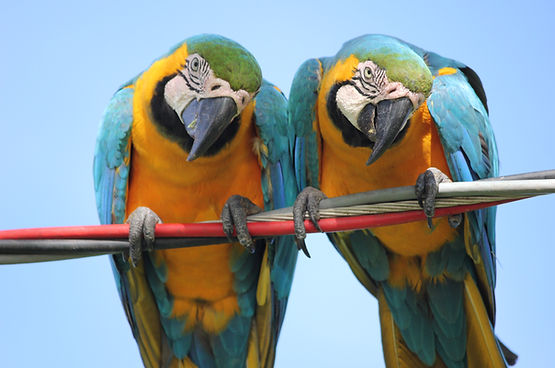top of page
ABOUT PARROTS
ABOUT PARROTS

Verde Macaw (hybrid Scarlet x Buffon’s) Macaw
Parrots, also known as psittacines, are extraordinary birds with many unique characteristics. With approximately 400 parrot species, parrots can vary in size from the Buff-faced Pygmy Parrot, at a little over three inches and weighing only around half an ounce, to the Hyacinth Macaw, around 40 inches and weighing nearly three pounds. However, New Zealand’s Kakapo, a nocturnal flightless bird, has been known to weigh up to nine pounds. Males and females are usually difficult to tell apart by observation, and often need a lab test to tell which is which. Parrot feathers contain unique bacteria-resistant pigments called psittacofulvins, which give the birds their colorful appearance and helps keep their feathers healthy.

Mexican Military Macaw
Parrots enjoy unique longevity. Some of the larger parrots, including cockatoos, macaws and amazons, have reported lifespans into their 80s, with anecdotal reports of lifespans over 100. A parrot named Charlie was allegedly owned by Winston Churchill, and is believed by some to be the oldest parrot on record, reportedly living over 104 years. Some smaller parrots such as budgies, lovebirds and hanging parrots have among the shortest lifespans, living around 5-15 years.

Scarlet Macaw
Parrots exist on every continent save Antarctica, and live at most elevations, from the Ouvéa Parakeet living at sea level, to the Kea, which can live up to 13,000 feet. Readily adaptable, parrots such as Lear’s Macaws and Yellow-shouldered Amazons are able to live in extremely dry climates, while some New Zealand parrots such as the Kea live on cold snow-covered mountains. Most parrots live in tropical and subtropical regions of Australia, Asia, Africa, and Central and South America. Though generally not migratory, some species are known to travel long distances, such as the Orange-bellied Parrot, which migrates between Australia and Tasmania across the Bass Strait, stopping on the way at King Island. There are only two nocturnal parrot species in the world, New Zealand’s Kakapo, and the very rare Night Parrot of Australia, residing in the Australian outback.

Harlequin (hybrid Green-winged
x Blue and Gold) Macaw
Parrots are known to have strong grips stemming from the configuration of their four toes, with two in front and two behind. Parrots are omnivores, and eat seeds, nuts, fruit, insects, and sometimes meat. In the 1800s, New Zealanders used to hunt Kea parrots that had been killing and eating sheep, a practice that continued until 1986 when they were granted protected status. While humans have over 9,000 taste buds, parrots have between 300 and 400 found on the roofs of their mouths, their tongues and the back of their throats, and are able to distinguish between salt, bitter, sour and sweet.

Blue and Gold Macaw
Parrots are highly social and intelligent birds, with birds being America’s fourth favorite pet after dogs, cats and fish. Parrots are known for their ability to imitate human speech as well as other sounds. Research has shown some parrots to have remarkable cognitive abilities. For example, an African Grey Parrot known as Alex had a vocabulary of only about 150 words, but was shown by Harvard researcher Irene Pepperberg to understand categorization, such as “same and different” and “bigger and smaller.” Alex could also identify objects by their shape, material and color. Dr. Pepperberg and her colleagues reported that Alex used its vocabulary in a sophisticated way, much like that of a five-year-old child. Many parrots have been known to have extraordinarily large vocabularies, most notably a parakeet named Puck, who was included in the 1995 Guinness Book of World Records for his ability to recognize 1,728 words.

Blue and Gold Macaw / Umbrella Cockatoo
Parrots in captivity require a great deal of attention, and if not sufficiently supervised, are prone to bad habits (like plucking out their feathers), and diseases such as Proventricular Dilatation Disease (PDD), an incurable wasting disease of parrots, likely of viral origin, that produces gastrointestinal and neurologic problems which are often fatal. The challenge for individual owners and parrot sanctuaries is to ensure that these marvelous birds have a varied diet and regular exercise. In addition, it is important for parrots to be given opportunities for frequent social interaction with other birds and their owners.

Green-winged Macaw
While some parrots in captivity are the result of breeding, most are the result of a worldwide trade in parrots taken from the wild. The extreme longevity of many parrots makes for a unique challenge in which a substantial number of birds outlive their owners, resulting in a growing population of orphaned parrots who either must be adopted by new owners, or live out their lives in bird sanctuaries and zoos.

African Grey Parrot
Parrot populations worldwide are declining due to low reproductive rates, worldwide poaching, and the destruction of their natural habitats. Many wild exotic parrots particularly are in danger of extinction, with governments around the world passing legislation to lessen the threat. In 1992, the U.S. passed the Wild Bird Conservation Act and CITES restrictions, which limits the import of exotic species, and has helped to lessen the threat. Many of these parrots are listed on the IUCN Red List of Threatened Species.
bottom of page